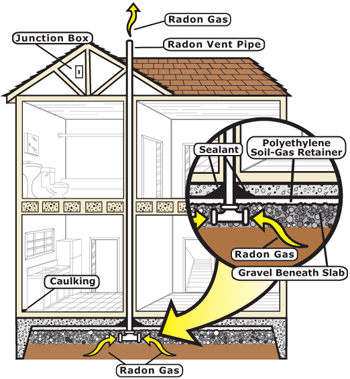Radon Resistant-New Construction
Incorporating radon-resistant new construction methods, or RRNC, into new
homes and structures can significantly reduce the risk of radon exposure and
avoid the costs of future mitigation. The following RRNC information is provided
by US EPA.
Overview
By building radon-resistant new homes, builders and contractors provide a
public health service — helping to reduce buyers’ risk of lung cancer from
exposure to radon in indoor air. Using common materials and straightforward
techniques, builders can construct new homes that are resistant to radon
entry.
Radon-resistant features can be an important selling point for
health-conscious home-buyers.
The cost to a builder of including radon-resistant features in a new home
during construction can vary widely. Many builders routinely include these
features in some of their homes. The cost to the builder of including these
features is typically less than the cost to mitigate the home after
construction.
RRNC, an integral part of the green building movement, is part of or
included in three labeling programs:
More than 1.5 million new homes have been constructed since 1990 with
radon-resistant features, based on an annual survey of builders conducted by the
National Association of Home Builders (NAHB) Research Center.
Radon-Resistant Construction Techniques
For more detailed techniques view Model Standards and Techniques for Control of Radon in New
Residential Buildings.
All of the techniques and materials described below are commonly used in home
construction. No special skills or materials are required when adding
radon-resistant features as a new home is being built.
While the techniques may vary for different house foundations and building
site requirements, the five basic features that builders should include to
prevent radon from entering a home are:

1. Gravel: Use a 4-inch layer of clean, coarse gravel below
the “slab,” also called the foundation. This layer of gravel allows the soil
gases, which includes radon, that occur naturally in the soil to move freely
underneath the house. Builders call this the “air flow layer” or “gas permeable
layer” because the loose gravel allows the gases to circulate. NOTE: In
some regions of the country, gravel may be too expensive or unnecessary.
Alternatives are allowed, such as a perforated pipe or a collection mat.
2. Plastic Sheeting or Vapor Retarder: Place heavy duty
plastic sheeting (6 mil. polyethylene) or a vapor retarder on top of the gravel
to prevent the soil gases from entering the house. The sheeting also keeps the
concrete from clogging the gravel layer when the slab is poured.
3. A Vent Pipe: Run a 3-inch or 4-inch solid PVC Schedule 40
pipe, like the ones commonly used for plumbing, vertically from the gravel layer
(stubbed up when the slab is poured) through the house’s conditioned space and
roof to safely vent radon and other soil gases outside above the house.
(Although serving a different purpose, this vent pipe is similar to the drain
waste vent, DWV, installed by the plumber.) This pipe should be labeled "Radon
System." Your plumber or a certified radon professional can do this.
4. Sealing and Caulking: Seal all openings, cracks, and
crevices in the concrete foundation floor (including the slab perimeter crack)
and walls with polyurethane caulk to prevent radon and other soil gases from
entering the home.
5. Junction Box: Install an electrical junction box (outlet)
in the attic for use with a vent fan, should, after testing for radon, a more
robust system be needed.
New home buyers may ask the builder about these features, and if not
provided, may ask the builder to include them in the new home. If a home is
tested after buyers move in and an elevated level of radon is
discovered, the owners’ cost of fixing the problem can be much more.
Constructing with RRNC in new homes can add value by protecting health
and reducing costs for your customers.